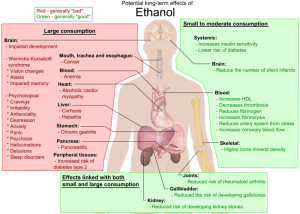Alcohol and Wellness – Enough is Enough
Moderation is the key.
Use of alcohol is a personal choice. Alcohol has been consumed by humans since pre-history for many reasons including water preservation, as a warming drink in cold climates, as an appetite stimulator or digestive aid after meals, as a flavoring in cooking, as a food source, for medical reasons, as a relaxant, for its euphoric effects, and for recreational effects. Whatever your reasons for consuming alcohol, or abstaining, it is best to make an informed decision. Like many things in life, alcohol consumption can have both positive and negative effects to consider and too much of almost anything can have negative effects on our health and wellbeing.
Alcohol contains 7 calories per gram, is the second most dense source of calories and often has little nutritional value compared to other foods. Alcohol is some times a forgotten source of calories in weight management routines and should be considered right along with any other calorie containing beverages. Below is a list of long term considerations for alcohol consumption.
Image Courtesy of Wikipedia
Limited and responsible alcohol use is shown to have some positive effects on health. Alcohol abuse on the other hand, can be a serious issue and should be managed in order to avoid it’s effects, which are noted as negative effects to health, interpersonal relationships, and ability to work. Alcohol is also associated with some lifestyle related diseases. Alcohol use can affect sleep, cause emotional disturbances, financial issues, and can increase stress levels. Although every individual is different and recommendations vary, the International Center for Alcohol Policy lists the United State’s official recommendations for safe alcohol use as 1-2 drinks per day and no more than 14 drinks per week for men, and 1 drink per day and no more than 7 drinks per week for women. The difference can be accounted for by the general difference in body size of men compared to women. 1 drink is classified as a 12 oz. glass of beer, a 5 oz. glass of wine, or 1.5 oz. of liquor. Be aware that anything over these amounts is considered “large consumption” or “heavy drinking”.
Stay Safe and Healthy if you Choose to Drink:
- If you’re not sure about the safety or effects, don’t drink
- If you do choose to drink, stick with recommended guidelines
- NEVER drink and drive, plan ahead, take a taxi, or decide on a sober driver
- Be sure to stay hydrated before, during, and after consuming alcohol. Drink at least one extra glass of water for each alcoholic drink
- Be aware of any possible interactions with both over the counter and prescription medications
- Avoid binge drinking (5 drinks for men, or 4 drinks for women within 2 hours)
- Set limits for yourself and stick with them
- Always consider age, body size, and any medical conditions if you choose to drink
- Be sure to eat before, during and after drinking
- While drinking may provide health benefits for some, don’t begin drinking for health benefits
If you believe you may have a problem with alcohol consumption, please contact a qualified professional or program as soon as possible. You can reach the National Drug and Alcohol Treatment Referral Routing Service available at 1-800-662-HELP. This service can provide you with information about treatment programs in your local community and allow you to speak with someone about alcohol problems.
Sources: CDC’s Alcohol and Public Health FAQ’s, Canada’s Low risk Drinking Guidelines, International Center for Alcohol Policy







